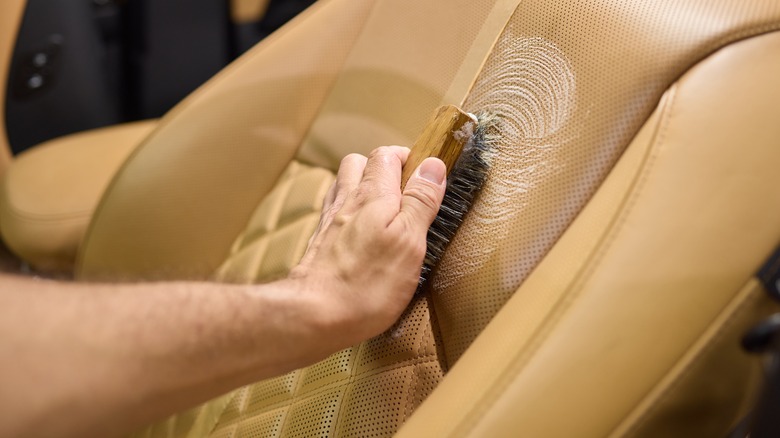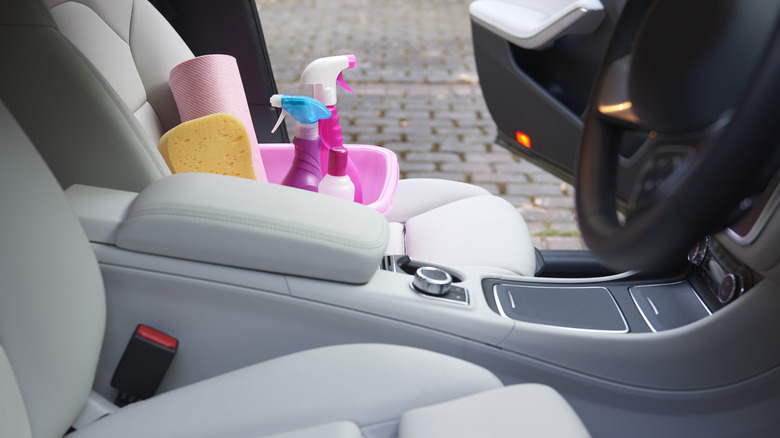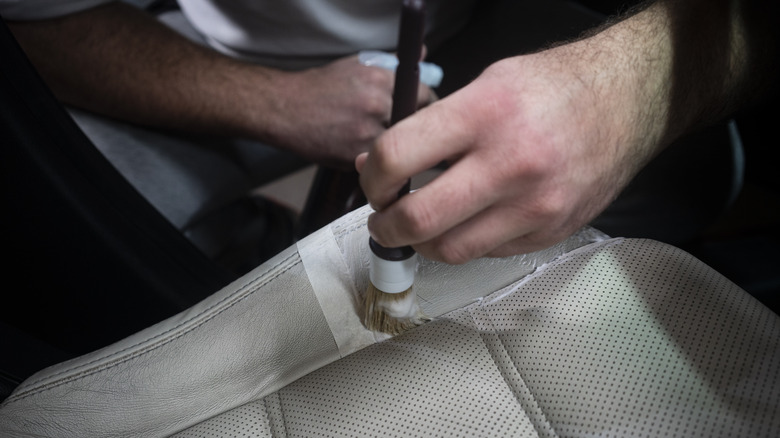How To Clean Perforated Leather Car Seats (And Get Grime Out Of The Holes)
We may receive a commission on purchases made from links.
Your seats are arguably the dirtiest part of your car's interior, after the floor and steering wheel. They are, after all, a frequent victim of accidental spills from drinks and snacks, not to mention dust buildup from regular use. Compared to fabric seats, you might find leather seats trickier to clean as they need special care. However, perforated leather car seats add another layer of difficulty.
Perforated car seats are seats with small holes. No, they're not entirely meant to add to the car's aesthetics — they're designed for safety and comfort, too. The perforations add friction to reduce the slippery feel of the seat and improve airflow, helping to keep you feeling cool and less sweaty in the summer. You'll want to avoid cleaning your car the wrong way and may prefer turning to professional detailing services instead, but if you want to go the DIY route, here's what you need to know to clean your perforated leather car seats at home.
Necessary cleaning materials for your leather seats
To clean your perforated leather car seats, you'll need some typical detailing tools. First off, get a vacuum ready. Make sure to use the vacuum's soft brush attachment, or, if you don't have one, wrap painter's tape around the nozzle to make the edges smoother and prevent any damage to the leather seats.
Next, prepare a soft bristle brush, ideally made out of natural horse hair. Horse hair brushes are effective at scrubbing grime off leather but gentle enough to protect it from scratches. If you're not a fan of brushing your leather seats, a can of compressed air might also do the trick. Additionally, you'll need microfiber applicator pads or microfiber towels for applying the leather cleaner and conditioner and drying off the car seats. Avoid any other type of cloths, especially the abrasive ones, unless you want to end up with scuffs on your leather.
Speaking of the cleaning and conditioning solutions, it's recommended to go with leather foam cleaners since they primarily stay on the surface and don't soak into the leather as much. You don't want the seats to be thoroughly wet, as the excess moisture can become visible stains. If you prefer mixing your own homemade cleaning solution for your car's leather seats, use Castile soap or gentle dish soap and lukewarm water. Ensure that the soap is free of alcohol, bleach, ammonia, acetone, and any other tough chemicals that can potentially cause discoloration or damage. Aside from the leather cleaner, have a leather conditioner on hand, too. Leather conditioners not only make your seats look fresh and new but also keep them hydrated and soft, preventing cracks from dryness and reducing overall wear.
The step-by-step cleaning process for your perforated leather car seats
With your materials ready, here's what you need to do to spruce up your perforated leather car seats:
- Vacuum the seating surfaces, sides, and crevices. Tilt the seats if you have to, and repeatedly run the vacuum over the dirtier perforated areas.
- Get rid of the grime from the perforations. Blow out the debris with the can of compressed air, keeping the nozzle a few inches away so it doesn't scratch the surface. For stubborn grime, gently scrub at it using your soft-bristled brush, then finish with several passes of your vacuum.
- Do a spot test to make sure your solution is safe to use. Apply it on a tiny, inconspicuous area like the base, clean off the residue, and come back after 15 minutes to check for discoloration or roughness.
- Apply the leather cleaner directly to either the microfiber applicator pad or soft bristle brush. Ensure it isn't soaking wet. Then, agitate the seats, gently scrubbing in circles from top to bottom and angling your brush to clean out the dirt from the sides of the perforations.
- Use a fresh microfiber cloth to wipe any extra solution that can cause spots or streaks. You may also want to vacuum the seat again to clear out the now-softened grime.
- Apply the leather conditioner. Spray it onto a different microfiber cloth, then spread it evenly across the seat. You may need to do another coat over spots with more wear. Afterward, wipe off the excess conditioner.
- Open the car to air dry the seats, but avoid the sun as it can discolor the leather. You can also turn on the heat if the seats are heated or use a wet vacuum to remove the excess solution.
Your seats should be looking clean and new by the end of the process.
Tips for keeping your perforated leather car seats clean
It may not take long before your perforated leather car seats return to their grimy state again, but there are simple things you can do to avoid deep cleaning your seats more often than you'd like. For one, make it a habit to vacuum the interior of your car regularly to clear out the loose debris from everyday use. This way, you'll prevent the dirt from lodging in the perforations and becoming harder to remove later.
For spills from things like your morning coffee or your kid's juice box, you shouldn't wait for your regular cleaning schedule to come along — just wipe them up right away. If the liquid has already soaked into the cushion, extract as much as you can with a wet vacuum. Then, proceed as usual: scrub the seat with the leather cleaner of your choice, remove the excess, apply the leather conditioner, blot out the residue, and let the seats dry. It's better if you can avoid eating and drinking in your car as much as possible. If you have pets that frequently ride with you, cover the seats with a blanket before they get in to minimize pet hair shedding that could potentially get into the holes.
Of course, a regular vacuum isn't enough, either. You'll still need to do some thorough cleaning every two to three months to prevent your leather car seats from cracking and keep them in generally good condition.



